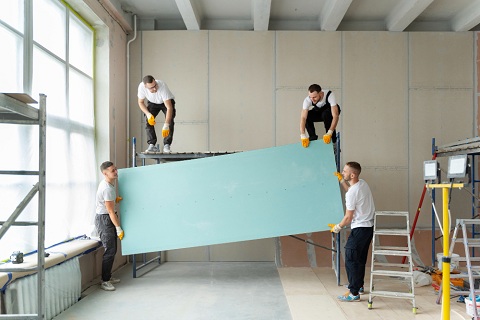Embarking on the journey of transforming your living space with a false ceiling is an exciting endeavor. To ensure a successful project, it’s crucial to make informed decisions when choosing the right materials for your false ceiling. This guide will take you through the essential aspects, from understanding the types of materials available to the installation process.
Understanding False Ceilings
Before delving into material options, let’s grasp the concept of false ceilings. Also known as drop ceilings, these secondary ceilings are suspended below the main ceiling, creating a unique aesthetic and providing functional benefits.
Benefits of a False Ceiling
False ceilings offer numerous advantages. They enhance acoustics, conceal wiring and pipes, provide insulation, and allow for creative lighting solutions. Now, let’s explore the materials that can bring these benefits to life.
Types of False Ceiling Materials
Choosing the right material is pivotal for the success of your false ceiling project. Here are six materials worth considering:
1. Gypsum Board Ceilings
Gypsum boards are popular due to their versatility and ease of installation. They offer a smooth finish and can be easily painted or adorned with textures.
2. Metal Ceilings
Metal ceilings exude a modern appeal and are resistant to moisture, making them ideal for kitchens and bathrooms. They are durable and require minimal maintenance.
3. PVC Ceilings
PVC ceilings are lightweight, cost-effective, and resistant to water and termites. They come in various designs and colors, allowing for creative expression.
4. Wooden Ceilings
For a warm and classic ambiance, wooden ceilings are an excellent choice. They add a touch of sophistication but may require more maintenance.
5. Fiberglass Ceilings
Fiberglass ceilings are known for their durability and resistance to moisture. They are suitable for areas prone to humidity, such as basements.
6. Mineral Fiber Ceilings
Mineral fiber ceilings offer excellent acoustic properties and are fire-resistant. They are a sustainable option and contribute to energy efficiency.
Factors to Consider
In making your decision, consider the following factors:
1. Durability
The longevity of the material is crucial. Choose a material that can withstand environmental conditions and daily wear and tear.
2. Aesthetic Appeal
Harmony with your interior design is vital. Select a material that complements the overall style of your space.
3. Maintenance
Evaluate the maintenance requirements of each material. Some may demand regular care, while others are low-maintenance.
4. Cost
Stay within your budget. Compare the cost of materials, considering both upfront expenses and long-term savings.
How to Install a False Ceiling
Once you’ve selected the material, the installation process is key to achieving a flawless outcome.
1. Preparing the Surface
Ensure the existing ceiling is clean and stable. Make any repairs or modifications as needed.
2. Installing the Framework
Create a sturdy framework to support the false ceiling. This step lays the foundation for a secure installation.
3. Placing the Ceiling Tiles/Sheets
Carefully place the chosen material, whether it’s gypsum board, metal, PVC, wood, fiberglass, or mineral fiber. Follow manufacturer guidelines for precise installation.
4. Finishing Touches
Add finishing touches, such as lighting fixtures or paint, to complete the transformation. Step back and admire your newly adorned space.
Choosing the Right Materials for Your False Ceiling: A How-To
Now, let’s delve into the specifics of choosing the right materials. Consider the unique requirements of each room and how the selected material aligns with your vision.
FAQs About Choosing the Right Materials for Your False Ceiling
The best material depends on your specific needs. For a versatile and easy-to-maintain option, gypsum board is often recommended.
While DIY is possible, professional installation ensures optimal results. Consider hiring experts for a seamless finish.
Most false ceilings are low-maintenance. Regular dusting and occasional cleaning suffice for most materials.
Yes, certain materials offer insulation benefits, contributing to energy efficiency and potential cost savings.
Durability varies by material. Generally, well-maintained false ceilings can last for decades.
Yes, false ceilings are versatile and can enhance the aesthetics and functionality of any room.
Conclusion
Choosing the right materials for your false ceiling is a transformative decision. Consider your preferences, budget, and the unique characteristics of each material. With the right choice and proper installation, you’ll elevate your living space to new heights.





